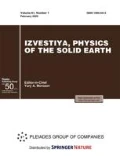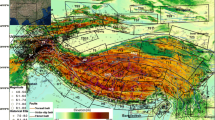Abstract
The spatial models describing the physico-mechanical properties of the rocks within the seismically active segment of the Altai–Sayan region are constructed from the ground-based geophysical data. The comparative analysis of their probability density functions at the nodes of the spatial grid covering the studied domain and at the hypocenters of the previous earthquakes shows that the bulk and shear moduli are the most efficient markers of the weakened crustal zones, which are prone to earthquakes. The algorithm for constraining the potential earthquake sources based on the spatial distributions of the elastic moduli of the rocks is suggested. When applied to the Taellin segment of the Altai–Sayan region, this algorithm has localized four echelons of the potential source zones of earthquakes at different depths in the crust. The horizontal positions of two of these zones were delineated by the previous studies based on the ground observations of seismicity, whereas the other two zones have been identified by the suggested algorithm for the first time.
Similar content being viewed by others
References
Blagovidova, T.Ya., Zhalkovskii, P.D., Muchnaya, V.I., Filina, A.G., and Tsirul’chik, I.D., The seismicity of the Altai–Sayan region from instrumental data, Geol. Geofiz., 1986, no. 1, pp. 140–147.
Dorbath, C., Van der Woerd, J., Arefiev, S.S., Rogozhin, E.E., and Aptekman, J.Y., Geological and seismological field observations in the epicentral region of the 27 September 2003 Mw 7.2 Gorny Altai Earthquake (Russia), Bull. Seismol. Soc. Am., 2008, vol. 98, no. 6, pp. 2849–2865.
Emanov, A.F., Emanov, A.A., Filina, A.G., and Leskova, E.V., Spatiotemporal features of the seismicity of the Altai–Sayan folded zone, Fiz. Mezomekh., 2005, vol. 8, no. 1, pp. 49–64.
Filina, A.G., The catalog of the Altai–Sayan earthquakes with A = 9 for 1963–1973, in Seismichnost’ Altae-Sayanskoi oblasti (Seismicity of the Altai–Sayan Region), Novosibirsk: IGiG SOAN SSSR, 1975.
Kadurin, V.A., Belyavskii, V.V., Egorkin, A.V., Zolotov, E.E., et al., Otchet po ob”ektu “Geofizicheskie issledovaniya seismorazvedochnymi i elektrorazvedochnymi metodami glubinnogo stroeniya Altae-Sayanskoi skladchatoi oblasti po profilyam obshchei protyazhennost’yu 3300 km. Organizatsiya i provedenie rezhimnykh geofizicheskikh nablyudenii na Tyvinskom poligone (Report on the Geophysical Study of the Deep Structure of the Altai–Sayan Folded Area by Seismic and Electric Resistivity Prospecting on the Profiles with a Total Length of 3300 km. Organization and Implementation of Geophysical Monitoring Observations in the Tyva Area), Rosgeolfond, 2008, no. 492309.
Kostyuchenko, S.L., Maukhin, A.V., Nedyad’ ko, V.V., Rakhitov, V.A., and Chernyshev, Yu.G. The new data on the cryustal structure and relation to the seismicity in the Altai–Sayan region from the results of the MCWE profile studies, Materialy XIX nauchno-prakticheskoi konferentsii “Aktivnye razlomy i ikh znachenie dlya otsenki seismicheskoi opasnosti: sovremennoe sostoyanie problemy” (Proc. 10th Workshop “Active Faults and their Prospects for Seismic Hazard Assessment: State of the Art of the Problem”), Moscow, 2014.
Krasnoramenskaya, T.G. and Lobatskaya, R.M., The volumetric neotectonic fault-block model of the Altai–Sayan folded area and seismic process, in Tektonofizika i aktual’nye voprosy nauk o Zemle. Vserossiiskoe soveshchanie k 40-letiyu sozdaniya M.V. Gzovskim laboratorii tektonofiziki v IFZ RAN (Tectonophysics and Topical Problems of the Earth Science. All-Russian Conference to the 40-Year Anniversary of Foundation by M.V. Gzovskii of the Laboratory of Tectonophysics at the IPE RAS), Moscow: IFZ RAN, 2008, vol. 2, pp. 56–58.
Krylov, S.V. and Ten, E.N., On estimating the lithosphere’s strength from the deep seismic sounding and geothermal data, Dokl. Ross. Akad. Nauk, 1994, vol. 337, no. 6, pp. 807–809.
Krylov, S.V. and Ten, E.N., The strength and elastic properties of the source zones of the strong earthquakes on the segments of the Baikal and Northern Tien Shan regions, Geol. Geofiz., 1995, vol. 36, no. 2, pp. 137–150.
Krylov, S.V. and Duchkov, A.D., The deep strain–strength zoning of the Earth’s crust by the example of the Altai–Sayan and Baikal seismic regions, Geol. Geofiz., 1996, vol. 37, no. 9, pp. 56–65.
Noveishaya tektonika, geodinamika i seismichnost’ Severnoi Evrazii (Recent and Contemporary Tectonics, Geodynamics, and Seismicity of Northern Eurasia), Grachev, A.F., Ed., Moscow: OIFZ RAN, 2000.
Spichak, V.V., Bezruk, I.A., and Goidina, A.G., Constructing the 3D cluster models of the geological medium from the geophysical data measured on the reference profiles, Razved. Okhr. Zemnykh Nedr, 2015, vol. 4, pp. 41–45.
Zhalkovskii, N.D., Kuchai, O.A., and Muchnaya, V.I., The seismicity and some characteristics of the crustal stress state in the Altai–Sayan region, Geol. Geofiz., 1995, vol. 36, no. 10, pp. 20–30.
Author information
Authors and Affiliations
Corresponding author
Additional information
Original Russian Text © V.V. Spichak, 2016, published in Fizika Zemli, 2016, No. 1, pp. 47–58.
Rights and permissions
About this article
Cite this article
Spichak, V.V. Constraining potential earthquake sources from the geophysical data. Izv., Phys. Solid Earth 52, 45–56 (2016). https://doi.org/10.1134/S1069351316010092
Received:
Accepted:
Published:
Issue Date:
DOI: https://doi.org/10.1134/S1069351316010092




